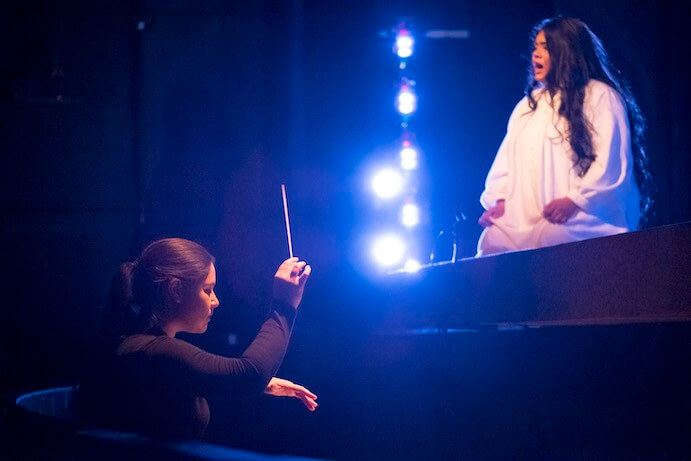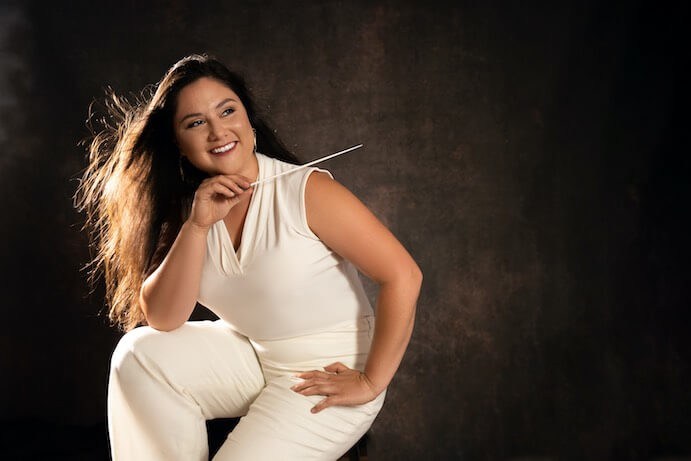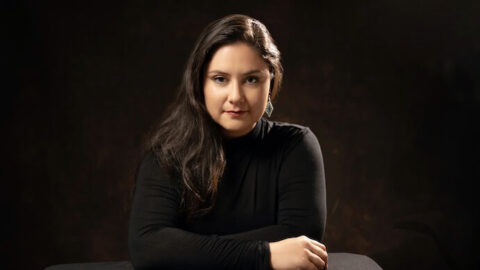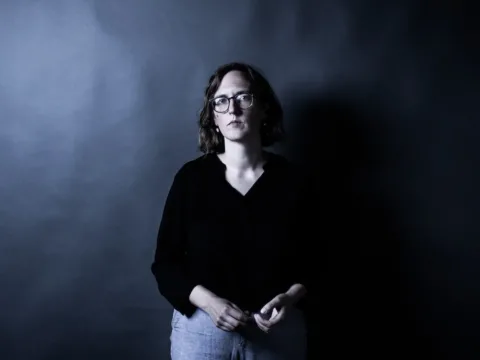Danielle Jagelski is a prime example of socially responsive artistry in the 21st century. Based in New York, her unique professional profile encompasses opera conducting, composition, modern operatic adaptation, as well as research in mixed-race studies and classical music. She is the artistic director and co-founder of Renegade Opera, an organization dedicated to making opera more accessible and inclusive for modern audiences.
As an enrolled member of the Oneida Nation of Wisconsin and Redcliff Band of Ojibwe with Polish settler heritage, Jagelski has worked with Native artists to “further the visibility of Indigenous peoples in the fine arts realm.” In March she assistant conducted the U.S.-premiere performances of Missing with Anchorage Opera. The chamber opera, by composer Brian Current and librettist Marie Clements, tells the story of the missing and murdered Indigenous women and girls (MMIWG) crisis in Alaska.
As someone who balances a career as a conductor, composer, and arts administrator, what are some of the benefits and challenges of being in these worlds simultaneously?
Living in these three worlds is a shared experience by many musicians, and though there are some challenges (such as time management), there is also a novel magic to this type of hybrid career. In my musical identity, these roles do not exist separately, but are all part of the same artistic practice. I don’t consider myself a “composing conductor” or a “conducting composer” — for me, one cannot exist without the other. Both conducting and composing teach me so much about music, and where I fit within this incredible space. I value collaboration above all else, and truly believe that we are a reflection of everyone around us. Being able to work with musicians in these two capacities continues to inspire and shape me with every new project.
When it comes to being an admin, I am grateful for the experience of being on both sides of what it takes to make performances happen. As a co-founder of Renegade Opera, the team and I set a goal at the beginning of our company to create an artistic space that is as productive as it is equitable, and the only way to do that is through intentional organization and planning on the administrative side. Having these skills allows me the freedom to work on music that I otherwise would not have had the opportunity to conduct or compose. Similar to composing and conducting, producing and performing cannot exist without each other, so I feel very lucky to know about both sides of the coin.

You have developed a long-term relationship with the Cincinnati-based choral ensemble Hear Us Hear Them. Would you tell us about this collaboration and your upcoming premiere of An Anthem?
I am so happy you brought up Hear Us Hear Them (HUHT)! This ensemble is truly something special. An Anthem is a collaborative piece written with Cincinnati’s Poet Laureate, Yalie Saweda Kamara. HUHT began the conversation with us in search of a piece that was thought-provoking as well as hopeful. HUHT is a choir focused on telling the stories of underrepresented musicians, and as it currently stands, much of the existing repertoire telling those stories is sad, slow, and even painful. When we all discussed what we would like to create, we came to the realization that we need music that is not just thought-provoking and true, but also uplifting and emboldened. We wanted music that was joyful, while not pushing the “hard stuff” under the rug.
Yalie’s words are so true to this concept, so I took the approach of staying true to the rhythm and musical elements that already existed within it. This was such a wonderful project, and really allowed me to work through some of the conversations many composers have with themselves, such as, “Is this writing ‘academic’ enough?” Yalie had also been told these things earlier in her career — that “you don’t want to be a sentimental writer.” But, truly, what does that mean? Does it mean that our music has to be difficult to understand in order to be ‘high art’?
I had a great conversation recently with HUHT Artistic Director Harry Mathurin-Cecil and Executive Director Jaime Sharp about serialism after WWII, how it was so needed after the atrocities, that it reflected the needs of the people after that difficult time. So we came to the question: What do we need now, here? I don’t know the answer exactly, but I know that — for me, at least — writing from the heart and writing from the mind do not have to be mutually exclusive.
I was fortunate to be at Samantha Williams’ American Patriots concert, where she premiered your song cycle gichi-mookomaan-aki. Could you talk about writing this cycle and the musical elements that inspired you?
This song cycle was born out of Samantha’s goal to explore what it means to be American from three different perspectives: Indigenous, Black Americans, and working-class white Americans. She conducted over 50 interviews with people from those communities, then commissioned composers of the corresponding identity. Writing this cycle was a unique process because our goal was to leave the text of the interviews as unaltered as possible.
There are 574 federally recognized tribes within the boundaries of the U.S., each with distinct and unique cultures. I am a citizen of the Oneida Nation and Red Cliff Band of Ojibwe on my mother’s side, and from Polish Catholic settler communities from my father’s side, and the interviewees were from a wide range of tribes, communities, and backgrounds. The goal of the project was not to try to represent the “Native American Experience” as a whole, because that would be impossible, but rather to dive deeper into each individual’s experience.
I took elements from the patterns of speech, and the subjects they discussed. For one of the songs, the interviewee spoke about being raised on a military base, describing the care that the military takes when raising and lowering the flag, and the care that is absent for many people who live in the U.S. I chose to take the melody of “Taps” and transform it with consideration to the duration of his answers to the questions, the number of words he chose to use, and where he paused within his descriptions to form the song. Other songs focus heavily on repetition; the words people shared with Samantha and me often repeated or circled back in the conversation, so I used music to make this more obvious to the audience. I think that when speaking, repetition can often be experienced as a distraction, but in music, repetition is a powerful device to invite people to listen a bit more carefully.
Much of your work is dedicated to promoting visibility for Indigenous artists. What are some clear and actionable ways that arts organizations can help?
This is an interesting question, and it has a giant/multifaceted answer that I am definitely not equipped to answer for the entire Indigenous community by myself. However, I am happy to steer people to some great work others are doing. In my opinion, each organization should take the time to analyze where they are when it comes to working with Indigenous performers, and where they would like to be. Native people are not a monolith, and neither is each arts community. Everything depends on the people in your community, the land you are living on, and the education level of the organization and audience.
A great place to start would be to engage with the Indigenous community from your local area, and then contact some existing organizations to educate your company on next steps, such as Indigenous Direction (Ty Defoe and Larissa Fasthorse), or First Nations Performing Arts (Emily Johnson and Ronee Penoi).
I will speak from my own experience and the experiences of my close collaborators — when you hire or commission a Native musician, do not do it with expectations of *Indigenous* work (cue ‘eagle cry’ sound effect); rather, focus on the work the artist wants to bring to you, which very well could have audible Traditional Native elements, but also may not. Do not commission them for what your audience and organization expect to hear from a Native artist, but rather for what they will bring from their own artistic practice. Put care into working with and hiring the musician, not the musician’s ethnic/racial, etc. identity. I believe this is a powerful way to fight tokenism.

What are some other upcoming projects that you are looking forward to?
Upcoming conducting engagements include Don Giovanni at Aquilon Music Festival on July 21-23; the live premiere of Adams Run by Ruby Fulton and Baynard Woods on Sept. 7-10, in Portland, with Renegade Opera; and Scalia/Ginsburg by Derrick Wangwith, on Sept. 23, with Opera Ithaca.
In composer land, I have two ongoing projects with a couple of my closest friends and collaborators. The first is a cello suite in collaboration with Philip Kettler (made possible by New Native Theatre) based on the original music I wrote for This Is How We Got Here by Keith Barker. The second is for solo percussion in collaboration with Colleen Bernstein, focusing on natural and artificially created patterns. Both of these humans have such generosity and curiosity in their work, as well as a physicality with their instruments that is so inspiring to me. With these two pieces, I am interested in writing for the specific player — I want someone to look at the score and recognize that this was written specifically for them. This type of writing takes time and care from everyone involved, but really allows us to “let the Ferrari out of the garage” and create a piece that is deeply connected to the player, the composer, and the relationship we’ve built.
I CARE IF YOU LISTEN is an editorially-independent program of the American Composers Forum, and is made possible thanks to generous donor and institutional support. Opinions expressed are solely those of the author and may not represent the views of ICIYL or ACF.
You can support the work of ICIYL with a tax-deductible gift to ACF. For more on ACF, visit the “At ACF” section or composersforum.org.
























